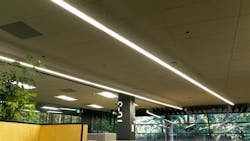As an installer, selecting the right lighting system can be a challenge — balancing client expectations, adhering to building codes, and navigating existing wiring constraints to name a few. It’s important to understand both the technical aspects of the system and how to communicate its benefits effectively to customers. To simplify this process, we’ve outlined a few key steps to identify which benefits you need from a lighting system upgrade and how to use this information to build a solid business case for your clients.
Step No. 1: Identify the key benefits
To start, you’ll need to understand your customer’s pain points. Consider the benefits you can offer while not creating additional challenges. There are smart but simple lighting systems utilizing wireless technology that reduce labor, material costs, installation time, and set-up — all while providing your customer with a fully adjustable solution that maximizes the benefits of LEDs. Additionally, these lighting systems are flexible and can accommodate space changes and rezoning without rewiring. They also streamline code compliance and allow for quick light-level adjustments with app-based tools, enhancing user comfort.
Luminaire-level lighting controls (LLLC) easily deliver these benefits. It’s a type of networked lighting control (NLC) system that integrates both sensors and load controllers into each luminaire, providing unparalleled flexibility, control, and energy savings. Unlike traditional luminaires requiring multiple switch legs, LLLC luminaires only need a single power connection, reducing labor and wiring complexity. Whether you’re working with new construction or retrofitting an existing space, LLLC can be customized to fit the needs of almost any project.
A flexible custom solution was what the Vancouver Innovation Center needed when it came time to upgrade its lighting system in Vancouver, Wash. With tenants moving in and out, they needed easy installation, simple commissioning, and the ability to reconfigure the space for any size tenant. After weighing the different lighting solutions and products, they ultimately chose a LLLC system.
Step No. 2: Leverage your local electric utility
Local electric utilities often have specialists who can help point you toward the best solutions for your project and can confirm whether your project qualifies for an incentive. These incentives can significantly offset costs, making LLLC an even more compelling choice. If you’re in the Northwest, the Northwest Trade Ally Network is another great resource for learning about lighting control systems. Be sure to compare the pricing of LLLC versus standard LED luminaires, and make sure the comparison includes electric utility incentives.
Fluke Corp., a multi-national manufacturer specializing in electronic test measurement based in Everett, Wash., wanted to upgrade its lighting system. They contacted their local electric utility, Snohomish County PUD, to learn more about their options. After analyzing energy savings potential, they discovered that retrofitting their current LED luminaires with the same LLLC system would yield more than enough savings to qualify for a utility incentive. Understanding the full savings potential of this upgrade — in terms of energy savings and utility incentives — helped influence the project’s decision-makers, ultimately resulting in resounding approval. The electric utility incentive covered half of the project’s capital cost, and Fluke is now saving 54,803kWh of energy annually.
Step No. 3: Build the business case
Once you have determined what your client needs in a lighting system and what financial incentives might be available, bring this to the decision-maker(s) for review. By considering factors like system performance, cost savings, increased energy efficiency, and electric utility incentives, you can ensure the right fit for both the project and the client’s needs.
Additionally, you can work with manufacturers to show a mock-up of the system by installing a one-room demonstration. Seeing firsthand the flexibility and benefits LLLC provide can be an impactful way to help stakeholders understand the value proposition of a future-proof lighting system.
About the Author
Dan Kuhl
Dan Kuhl has more than 35 years’ experience in the energy sector working as a manufacturer’s representative and electrical distributor and has spent the last 10 years at Evergreen Consulting Group, focused on working directly with trade allies and utility personnel. He is a subject matter expert as well as an experienced trainer, delivering over 60 trainings in 2019 alone for utilities including Bonneville Power, Com-Ed, and Pacific Power. Dan is a certified instructor for the Building Operator Certification (BOC) program and he specializes in delivering turn-key trainings for industry partners including market research, content development, and innovative supplemental materials designed to engage participants.
